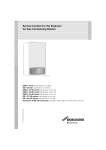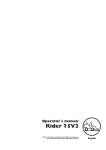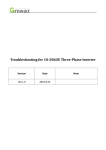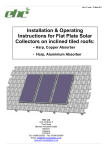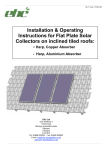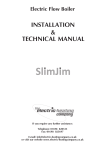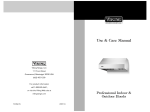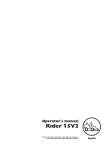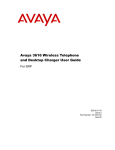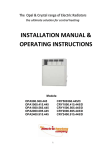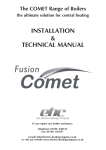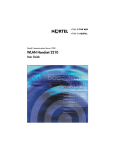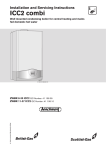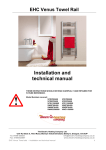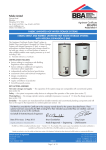Download Operating instructions
Transcript
EHC Solar E10 Combi Series Solar Combination Boiler Range Installation and Technical Manual THESE INSTRUCTIONS SHOULD BE READ CAREFULLY AND RETAINED FOR FUTURE REFERENCE. This Manual is provided to assisit the installation and mainteneance of the following EHCSCOMB9/180 EHCSCOMB12/180 EHCSCOMB14/180 The E10 Solar Combi must be installed by a competent person with accordance with this installation manual and all relevant regualtions in force at time of installation The Fusion E10 combination unit’s Unvented Cylinder is a controlled service as defined in the latest edition of the building regulations. The relevant regulations are: England and Wales – Building Regulation G3 Scotland – Technical Standard P3 N Ireland – Building Regulation P5 After installation the Benchmark log table on page 31 must be completed and left with the householder for future reference. The Electric Heating Company Ltd Unit 40, Block 5, Third Road, Blantyre Industrial Estate, Blantyre, Glasgow, G72 0UP Tel. 01698 820533 Fax. 01698 825697 [email protected] www.electric-heatingcompany.co.uk Contents Page 1. Introduction 3. 2. Safety 3. 3. Storage, handling & unpacking 4. 4. Contents Check List 5. 5. Key Components 6. 6. Technical Specifications 7. 7. Installation – Siting 9. 8. Installation - Plumbing 10. 9. Installation - Discharge arrangement 12. 10. Installation - External pipework schematic 14. 11. Installation – Central Heating pipework 15. 12. Installation – Electrical 17. 13. Commissioning – General 21. 14. Commissioning – Programmer Setting 23. 15. Commissioning – Fusion Boiler 27. 16. Servicing 29. 17. Trouble shooting 30. 18. Benchmark Service Record 31. 19. Guarantee 32. Warranty registration Please ensure that the warranty card is completed and returned to the EHC by post, or you can register the Combination Unit online at www.electric-heatingcompany.co.uk. EHC Fusion E10 Solar Combi – Installation and technical manual Page 2 1. Introduction Thank you for specifying the Fusion E10 Solar Combi Boiler from The Electric Heating Company. The Fusion E10 Solar Combi is an integrated electric flow boiler and solar panel TM heated Duplex SSTL unvented domestic heating cylinder with back up immersion heater. This appiance is not intended for use by persons (including children) with reduced physical, sensory or mental capabilities, or lack of experience and knowledge, unless they have been given supervision or instruction concerning use of the appliance by the person responsible for their safety. Children should be supervised to ensure they do not play with the appliance. The Electric Heating Company reserves the right to make minor changes to the specification or design when necessary. 2. Safety Please read and understand these instructions before installing the Fusion E10 Combi. Following installation and commissioning the operation of the Fusion E10 Combi, the central heating system and associated controls should be explained to the customer and these instructions left with them for future reference. The Fusion E10 Solar Combi must be installed in accordance with the manufacturer’s instructions and all relevant regulations in force at the time of installation. The Fusion E10 Solar Combi’s Domestic Hot Water Cylinder is of the UNVENTED type. Its installation is subject to Building Regulation G3 (England and Wales), Technical Standard P3 (Scotland) or Building Regulation P5 (Northern Ireland). Installation must be carried out by a competent person. The Fusion E10 Solar Combi electric central heating boiler must be installed into a sealed (pressurised) primary system. Following installation of the primary system the system should be flushed in accordance with BS 7593 and an inhibitor added. The E10 solar Combi hot water cylinder is indirectly heated by Solar panels 9not supplied). Additionally the hot water cylinder has an immersion heater for backup. Please note a load check should be taken into consideration when installing high output electrical appliances. The use of an Off-Peak tariff that provides at least three off peak electricity periods, such as Economy 10 from Scottish and Southern Energy, is recommended. Where possible the central heating and hot water “on” periods should be programmed to coincide with the off peak electricity periods available. For more information on the best use of the Economy 10 tariff please contact the Electric Heating Company direct C.O.S.H.H. Materials used in the manufacture of the Fusion E10 Combi are non-hazardous and no special precautions are required when fitting or servicing the appliance. EHC Fusion E10 Solar Combi – Installation and technical manual Page 3 3. Storage, handling & unpacking The Fusion E10 Solar Combi is protected in corrugated packaging with reinforced corner posts. The assembly is wrapped in heavy duty polythene. The Fusion E10 Solar Combi unvented fitting kit is supplied within the boiler. The assembly must be stored upright, under cover in dry conditions. Units must not be stacked. The packaging must be removed prior to installation. Note the weight of the product and the handling instructions applied to the packaging. If using a handling device, eg. a sack barrow, to manually move the Fusion E10 solar Combi, trucking must be done from the rear to avoid damage to the outer panels. The Fusion E10 Combi should be lifted and handled by two persons. Handholds are provided in the top rear panel and underneath at the front of the Fusion E10 solar Combi assembly to aid lifting. Stooping should be avoided and protective clothing worn when necessary. Care must be taken when removing the packaging to avoid any damage to the surface of the unit. The packaging is recyclable and should be disposed of in accordance with environmental guidelines. EHC Fusion E10 Solar Combi – Installation and technical manual Page 4 4. Contents check list The following components are supplied in the bag at the front of the Fusion E10 Solar Combi cabinet. Please check that all parts are present and available before commencing installation. Note if your unit is a non standard type there may be additional components these should be checked against your order EHC Fusion E10 Solar Combi – Installation and technical manual Page 5 5. Key components 1. 2. 3. 4. 5. 6. 7. 8. 9. 10. 11. 12. 13. 14. 15. 16. 17. 18. 19. 20. Programmer Rear compartment – expansion vessels Enclosure Fusion Slim-line Boiler Rear Compartment 180L Cylinder Flow and Return to Solar Panel Solar Pressure Relief Outlet Solar filling connections Solar Controller Solar Pump Set Removable door retaining clips Domestic Hot water Temp/Pressure Relief Outlet Domestic Hot water Outlet Central Heating Pressure Relief Outlet Magnetic filter Immersion Heater Cold Main Central Heating Return Central Heating Flow Solar Sensor 1 2 3 4 5 6 7 8 9 10 11 12 13 14 15 Control Panel Over-heat cutout Automatic air vent Heating elements Copper heat exchanger Printed circuit board Voltage free control connections Circulation pump Flow and Return sensors Flow switch Pressure gauge Heating flow Heating return Pressure relief valve Enclosure EHC Fusion E10 Solar Combi – Installation and technical manual Page 6 6. Technical specifications________________________ General 9 kW Heating output 30,717 Btu Electricity Supply Boiler range 12 kW 40,956 Btu 14.4 kW Cylinder 49,147 Btu 230/240V single phase 50Hz Load/Current 39.1 Amps 52.2 Amps 62.6 Amps Protection required 45.0 Amps 63.0 Amps 80.0 Amps CH Max temp setting Factory setting 85°C CH Min temp setting 40°C CH Overheat protection 100°C Pump included Yes Recommended pump setting Maximum CH Flow and Return pipes 22mm Domestic & Primary connections 22mm Min Water Pressure 1.0 Bar 3.0 Bar Max Water Pressure 3.0 Bar 7.0 Bar Expansion Vessels 8 litre 12 litre Immersion heater 3.0 kW Solar Pump Station Material: Fittings Brass Flat sealings Klingerit, max. 200 Deg C. O ring seal VITON/EPDM, max 180 Deg C. Solar Non return Valve PPS, max 180 Deg C. Insulation EPP, max. 120 Deg C Continuous and up to 180 Deg C intermittent Admissable max. temp 0 - 120 Deg C, continuous and up to 180 Deg. C intermittent Connections 3/4 " IT Cirulation Pump Wilo Star ST20/6 Power Supply 220-240 V Opperating pressure max. 8 bar Spring Pressure of non-return valve 200mm head Flowmeter 0.5-5 L/min. 1-13L/min (standard) or 8-30L/min EHC Fusion E10 Solar Combi – Installation and technical manual Page 7 6. Technical specifications/ Cont..._________________ Dimensions 180 litre Dry weight 104 kg Full weight 290 kg Dimensions 1620 x 574 x 750 mm 500mm Recommended Clearance 20mm 200mm EHC Fusion E10 Solar Combi – Installation and technical manual 50mm Page 8 7. Installation: siting Choosing a location The Fusion E10 solar Combi must be installed indoors in a dry and frost free environment. It must be vertically mounted on a flat, level surface capable of supporting the full weight of the unit. When full the unit weighs a total of 290kg. Consideration must be given to maintenance – clearance must be left around the boiler to allow the front and top panels to be removed and to allow access to the external pipework and controls. Care must be taken when lifting this unit. A two man lift is recommended. Hand holds are provided in the case at the top rear and bottom front of the unit. Removing the panels For installation, the front door and top panel cab be removed. 1. Door B is secured by two spring clips at point C. There are two locating studs for door at point D. To remove apply light force at edge around point C. Once released angle back approx 15 degrees. Then lift vertically to remove studs at point D from their location. Be careful to store the door where it cannot be damaged. 2. Lid A has no securing areas and can be lifted directly off the unit. All EARTH connections must be reconnected to removable side panels A B C D EHC Fusion E10 Solar Combi – Installation and technical manual Page 9 8 Installation: Plumbing Water supply requirements The Fusion E10 solar Combi operates at 3 bar (controlled by the inlet control set) and is capable of delivering over 50 litres per minute. The high quality inlet control set has been designed to make the most of the flow rates available, however the performance of any unvented system is only as good as the mains water supply to the unit. The maximum possible water demand should be assessed by taking into consideration that both hot and cold services are supplied simultaneously from the mains. The water supply should be checked to ensure it can meet these requirements. If necessary consult the local water company regarding the likely pressure and flow rate availability. If measuring the water pressure, please note that a high static (no flow) mains pressure is no guarantee of a high flow rate. In a domestic installation 1.5 bar and 25 l/m should be regarded as the minimum. The maximum recommended mains pressure for the inlet control set is 16 bar. Consideration should be given to upgrading existing ½” (15mm) cold mains pipework to a larger size if the recommended minimum pressure/flowrate is not being achieved. Cold mains pipework Example 1. Run the cold main pipework to where the Fusion E10 solar Combi unit is to be installed. Take care not to run the cold mains pipework near the hot water or heating pipe work so that heat pick up is minimized. 2. Identify the cold water supply pipe and fit an isolating valve (not supplied). A 22mm BS1010 stopcock can typically be used, however a 22mm quarter turn full bore valve is preferable as it does not restrict the flow as much. Do not use “screwdriver slot” or similar valves. 3. Make the connection to the cold feed of the Fusion E10 solar Combi and incorporate a drain valve. Position the inlet control immediately above the Temperature & Pressure Relief Valve (TPRV) mounted on the side of the unit (see diagrams below). This ensures that the unit does not have to be drained down in order to service the inlet control set. Ensure that the arrow points in the direction of the water flow. EHC Fusion E10 Solar Combi – Installation and technical manual Page 10 8. Installation: Plumbing/ Cont.. Balanced cold connection If the system includes showers, bidets or monobloc taps, then a balanced cold supply is necessary. Do not use monobloc mixer tap or showers if the balanced cold connection is not used. Outlets of this type can back-pressurise the unit and result in discharge. A 22mm balanced cold mains outlet can be found on the control set supplied, (see diagram below) Use the balanced cold mains outlet from the inlet control set (as shown in the illustration) to feed all mixer taps / showers, instead of connecting them to the cold main.If the control set supplied with your Fusion E10 solar Combi unit is of the two part type it can be split into its two main assemblies. Site the pressure reducing valve immediately after the incoming cold mains stopcock (typically under the kitchen sink). All outlets in the house will be set to 3 bar and thus automatically balancing the system. The expansion relief valve section must still be mounted just above the TPRV on the cylinder (see diagram below). Hot Water pipework Ensure the first part of the hot water pipework is run in 22mm pipe. This can reduce to 15mm/10mm depending on the type of tap etc. Your aim should be to reduce the volume of the hot draw off pipework to a practical minimum so that the time taken for the hot water is as quick as possible. EHC Fusion E10 Solar Combi – Installation and technical manual Page 11 9. Installation: discharge arrangement The above diagram is of a typical discharge pipe arrangement. (extract from Building Regulation G3) Note: The discharge will consist of scalding water and steam. Asphalt, roofing felt and nonmetallic rainwater goods may be damaged by such discharges. Note: It is not acceptable to discharge straight into a soil pipe. Position the inlet control group so that the discharge from both the two safety valves can be joined together via a 15mm end feed Tee. Connect the Tundish and route the discharge pipe. The discharge pipework must be routed in accordance with Part G3 of schedule 1 of the Building Regulations. The information that follows is not exhaustive and if you are in doubt you should seek advice. The two safety valves will only discharge water under fault conditions. When operating normally water will not be discharged. The tundish should be vertical, located in the same space as the unvented hot water storage system and be fitted as close as possible and within 500mm of the safety device e.g. the temperature relief valve. The discharge pipe (D2) from the tundish should terminate in a safe place where there is no risk to persons in the vicinity of the discharge, be of metal and: A) Be at least one pipe size larger than the nominal outlet size of the safety device unless its total equivalent hydraulic resistance exceeds that of a straight pipe 9m long i.e. discharge pipes between 9m and 18m equivalent resistance length should be at least two sizes larger than the the nominal outlet size of the safety device, between 18 and 27m at least 3 sizes larger, and so on. Bends must be taken into account in calculating the flow resistance. Refer to diagram 1, Table 1 and the worked example. An alternative approach for sizing discharge pipes would be to follow BS6700 Specification for design installation, testing and maintenance of services supplying water for domestic use within buildings and their curtilages. B) Have a vertical section of pipe at least 300mm long, below the tundish before any elbows or bends in the pipework. EHC Fusion E10 Solar Combi – Installation and technical manual Page 12 9. Installation: discharge arrangement /cont C) Be installed with a continuous fall. D) It is preferable for the discharge to be visible at both the tundish and the final point of discharge but where this is not possible or practically difficult there should be clear visibility at one or other of these locations. Examples of acceptable discharge arrangements are: 1. Ideally below the fixed grating and above the water seal in a trapped gulley. 2. Downward discharges at a low level; i.e. up to 100mm above external surfaces such as car parks, hard standings, grassed areas etc. are acceptable providing that where children play or otherwise come into contact with discharges, a wire cage or similar guard is positioned to prevent contact whilst maintaining visibility. 3. Discharges at a high level; e.g. in to metal hopper and metal down pipe with the end of the discharge pipe clearly visible (tundish visible or not) or onto a roof capable of withstanding high temperature discharges of water and 3m from any plastic guttering systems that would collect such discharges (tundish available). 4. Where a single pipe serves a number of discharges, such as in blocks of flats, the number served should be limited to not more than 6 systems so that any installation can be traced reasonably easily. The single common discharge pipe should be at least one pipe size larger than the largest individual discharge pipe to be connected. If unvented hot water storage systems are installed where discharges from safety devices may not be apparent i.e. in dwellings occupied by blind, infirm or disabled people, consideration should be given to the installation of an electronically operated device to warn when discharge takes place. Worked example The example below is for G1/2 temperature relief valve with a discharge pipe (D2) having 4 No. elbows and length of 7m from the tundish to the point of discharge. From Table 1: Maximum resistance allowed for a straight length of 22mm copper discharge pipe (D2) from a G1/2 temperature relief valve is: 9.0m Subtract the resistance for 4 No. 22mm elbows at 0.8m each = 3.2m Therefore the maximum permitted length equates to: 5.8m 5.8m is less than the actual length of 7m therefore calculate the next largest size. Maximum resistance allowed for a straight length of 28mm pipe (D2) from a G1/2 temperature relief valve equates to: 14m As the actual length is 7m, a 28mm (D2) copper pipe will be satisfactory. Table 1 Sizing of copper discharge pipe ‘D2’ for a temperature relief valve with a G1/2 outlet size (as supplied). Size of discharge pipework Maximum length of straight pipe (no bends or elbows) Deduct the figure below from the maximum length for each bend or elbow in the discharge pipe 22mm 28mm 35mm Up to 9m Up to 18m Up to 27m 0.8m 1m 1.4m EHC Fusion E10 Solar Combi – Installation and technical manual Page 13 Tundish Pressure Reducing set Fusion Combination Unit (side View) Cylinder EHC Fusion E10 Solar Combi – Installation and technical manual Drain Valve to be fitted at lowest point. Central Heating Flow Central Heating Return Cold Feed Mains Water Connection This must not be fixed pipe work The use of a filling loop will be required and disconnected after use Drain Off for Cyl Central Heating Pressure Relief Outlet Domestic Hot Water Min 300mm Hot Water Temp Pressure Relief Outlet Isolator 10. Installation: External pipework schematic Hot Water Fusion Electric Boiler Page 14 11. Installation: Central Heating pipework____________ Flow and return connections are located at the bottom of the left hand side of the unit. We recommend compression joints at this point to prevent damage to the units internal seals. The return connection will need to temporarily incorporate a filling loop as shown in the diagram below. Reference should be made to BS 6798 for methods of filling and make up of water. RN TU RE W O FL There must be no direct/permanent connection between the central heating system and the mains water supply all filling loop connections must be removed, ( local water bylaws must be observed) System Design As the Fusion E10 boiler is of low water content an open circuit must be achieved at all times. Allowances should made for a system bypass radiator or valve. This radiator should be installed in the same room as the room thermostat. Flow rates can be obtained from the control panel on the fusion boiler by pressing the right-hand arrow key until the L/min LED illuminates System Flushing When the Fusion E10 solar Combi is being installed into an existing central heating system we highly recommend that the system is power flushed to prevent contamination from existing debris and magnatite. The Fusion E10 boiler has an inbuilt magnetic filter to protect internal components and pump. EHC Fusion E10 Solar Combi – Installation and technical manual Page 15 11. Installation: Central Heating pipework/Cont_________ System Pressures The normal working pressure of the Fusion E10 boiler should be set to 1.5 bar. All sealed systems should comply with current building regulations and standrads All Fusion E10 Solar Combi units are water and pressure tested before leaving the factory. However all compression joints must be checked again at installation due to the possibilty of transit movement. System protection Failure to protect the system will invalidate the manufacturer’s warranty. After the system has been installed the cleansing and inhibiting procedure must be carried out as follows: 1 Fill the system with cold mains water to the recommended pressure and check for leaks, then drain the system thoroughly making sure all drain cocks are fully open and that the system is completely drained. 2 Add Fernox S5 via a Fernox injector or radiator at the recommended dose. One bottle must be used as a minimum per dwelling. If you are not sure of the dose rate, then contact Fernox. 3 Fill the system back up and circulate the Fernox S5 before the boiler is fired up. Then commission the system in the normal way. The cleansing agent must be in the system for a minimum of I hour with the system at normal operating temperature. A longer period of time would be more beneficial to the cleansing process especially if excess flux was used. 4 Drain and flush the system thoroughly to remove the cleaning chemical and debris present. This is a crucial part of the cleansing process and must be done correctly. Use a rinse test meter (TDS), such as the Fernox CTM. The reading must be within 10% of the mains ppm value. 5 Once the system has been cleansed thoroughly, then add a Fernox Protector (Copal, MB1 or Superconcentrate), to the system. The product must be added as per the manufacturer’s instructions. This will protect against the formation of scale, corrosion and microbiological growths. lt is crucial, however, that for a protector to work correctly, the system must be properly cleansed and flushed. 6 The sticker included within the Fernox Protector carton should be correctly filled in and attached adjacent to the boiler. 7 Please note: we recommend inhibitor levels are checked on an annual basis (usually during the service) or sooner if the system content is lost. This should be carried out using a Fernox inhibitor test kit. 8 Fernox Technical Services can be contacted on 0870 8700362 for further assistance. NB: Motorised valves should be manually opened during the flushing process and any antigravity valves should be by-passed or removed temporarily. If it is necessary to cap off the open vent during the mains flush – to prevent overflow ensure the cap is removed prior to starting the appliance. Advice as contained within BS 7593:1992 and PAS33:1999 should be followed in conjunction with this method statement. EHC Fusion E10 Solar Combi – Installation and technical manual Page 16 12. Installation: Solar Filling_________ For full Solar Install detail please refer to seperate Flowcon A installation manuall 13. Installation: Solar Connections________ * Note it there is not sufficient space this valve can removed and blanked. The Pressure relief valve can then be installed in an alternative position. For example – When installed in an attic space the valve outlet can be taken to a sump collection point such as a feed and expansion tank. Additionally any glycol found in the expansion tank can be re-used in the solar circuit. EHC Fusion E10 Solar Combi – Installation and technical manual Page 17 12. Installation – Electrical All electrical connections must be made by a qualified person. All wiring must be carried out in accordance with current IEE regulations. BS7671 (17th edition) THIS APPLIANCE (including all pipework) MUST BE EARTHED A load check should be carried out to ensure that there is sufficient current and voltage for the intended boiler installation. Consideration should be taken into account with regard to the remainder of the properties load requirements. All boilers must be protected with a double pole RCD with a trip sensitivity of 30mA, capable of breaking the full load current to BS EN 61008:1994. Additionally a double pole switch with a minimum of 3mm contact separation must be installed local to the boiler. Boiler control wiring, the boilers internal controls are prewired within the unit using a plug-it system for easy replacment of components. The control power supply cable exits the boiler on the left hand side, this cable must be connected and protected via a 3 amp fused spur and wired so that when the main power to the boiler is removed the control circuit is isolated. When other high current devices are installed within the same property, (eg: electric showers,) we recommend that our flow sensor should be installed interrupting the volt free control signal to the boiler when the shower is in use. Cable entry positions The electrical supply cables can be routed from the top left hand panel of the unit (see Diagram below). There are 3 cable entry holes, 2 at the top of the left hand side panel and 1 on bottom right. Cable grommets are supplied and fitted to the boiler‘s cable entry points. All cables should be secured to meet current regulations. Cable ties are provided within the fusion boiler to secure incoming power cables. Immersion heater mains supply The Fusion E10 Solar combi is fitted with a 3 Kw immersion heater. It is recommended that this is connected as per wiring diagrams on pages 19 & 20. EHC Fusion E10 Solar Combi – Installation and technical manual Page 18 12 Installation – Electrical Wiring Diagram (Standard) EHC Fusion E10 Solar Combi – Installation and technical manual Page 19 1 1 3 Amp 2 TLX 4101 2 TLX 4101 Zone 1 Actuator Zone 2 Actuator N A1 1 A1 EHC Fusion E10 Solar Combi – Installation and technical manual C16 C63 Consumer Unit C6 10 9 8 7 6 5 4 3 2 1 Wiring Centre L 3 4 VOLT FREE CONNECTIONS N 6 R P Solar Controller Fusion Boiler VOLT FREE CONNECTIONS Select 307 Programmer 12 Installation – Electrical Wiring Diagram (2 Zone) with 3 Channel Programmer Relay 1 Relay 2 Immersion Heater R3 A2 R4 1 2 R3 R4 A2 2 Page 20 13. Commissioning: Genaral IMPORTANT: DO NOT SWITCH ON THE ELECTRICAL SUPPLIES TO THE FUSION E10 COMBI UNIT UNTIL THE CYLINDER AND PRIMARY CIRCUIT HAVE BEEN CORRECTLY FILLED WITH WATER. Filling the cylinder 1 Check that all pipe connections to the Fusion E10 Combi are tight. 2 Open a hot tap furthest from the Fusion E10 Combi. 3 Check the Primary System Filling Loop isolating valves are closed. 4 Open the cold water supply isolating valve and allow the Fusion E10 Combi cylinder to fill. When water flows from the tap, allow to run for a few minutes to thoroughly flush through any residue, dirt or swarf, then close tap. 5 Open any other hot and any cold services supplied by the balanced cold outlet to remove any air from the system. 6 Check all connections (including immersion heater) for leaks and rectify as required.. 7 The strainer housed within the Cold Water Combination Valve should be cleaned to remove any debris that may have been flushed through the main supply pipe. Filling the sealed system primary circuit 1 The primary system must be flushed in accordance with BS 7593 and the manufacturer’s instructions supplied. Failure to to do this will invalidate warranty. 2 Connect the Filling Loop and tighten connections. 3 Check all radiator valves are in the open position. 4 Open the Filling Loop isolating valves and allow primary system to fill until the pressure gauge on the fascia of the Fusion E10 Solar Combi reads approx. 2.0 bar. 5 Purge air from all radiators and air vent points in the primary system including the pump in the fusion boiler 6 Check the primary system pressure. This should be between 1.0 and 1.5 bar. If lower, open Filling Loop isolating valves until gauge reads approx. 2.0 bar. Repeat air purging operation. This sequence may need to be repeated several times to ensure all air is purged from the system. 7 Check primary system for leaks and rectify as necessary. 8 When the pressure gauge remains steady at between 1.0 and 1.5 bar ensure both Filling Loop isolating valves are closed and remove Filling Loop flexible hose from the Primary system connection point. EHC Fusion E10 Solar Combi – Installation and technical manual Page 21 13. Commissioning General/Cont. Check Safety Valves Operation 1 Check Temperature and Pressure Relief Valve 2 Check pressure relief valve on reducing set 3 Check that all pressure relief valves flow through tundish outlet Preliminary Electrical Checks 1 Check all electrical connections are tight. Loose connections can cause over-heating of terminals and the possibility of a fire. 2 Check all earth bonding links are connected, are tight and un-damaged. 3 The electrical system should be checked for Earth Continuity, Short Circuits, Polarity and Resistance to Earth. 4 the backup immersion heater should be set to 65 deg – this can be achieved by removing the cover and adjusting the thermostat dial as required. Start up 1 Switch on all power supplies to the fusion boiler. At this stage the boiler will automatically run the system pump Ensure that all air has been removed from pump. 2 Switch on power supply to external control circuit 3 Select desired times for heating and hot water on the twin channel programmer as per instructions on page 23. It is beneficial to set the program around the Economy 10 tariff where possible. 4 Switch twin channel programmer to cont on both heating and hot water 5 Further bleed system if required 6 At this stage set the automatic bypass to 8l/m with all thermostatic radiators valves closed. After this been achieved open all thermostatic radiators valves. 7 Set system temperature on the Fusion E10 boiler to 65°C as per instructions 8 Set Thermostat to Max temperature 9 Allow system to circulate 10 After the system has circulated and reached desired temperature. The system can then be set to the individual users‘ preference EHC Fusion E10 Solar Combi – Installation and technical manual Page 22 14. Commisioning: Programmer 2 Channel Note:if you have a 2 Zone system with 3 channel Programmer, Please refer to the enclosed 3 Channel Programmer user guide (Select 307 XLS ) The programmer allows you to set ON OFF time periods. Some models switch the domestic hot water on and off at the same time, while others allow the domestic hot water and heating to come on and go off at different times.Set the ‘On’ and ‘Off’ time periods to suit your own lifestyle. On some programmers you must also set whether you want the heating and hot water to run continuously, run under the chosen ‘On’ and ‘Off’ heating periods, or be permanently off. The time on the programmer must be correct. Some types have to be adjusted in spring and autumn at the changes between Greenwich Mean Time and British Summer Time. You may be able to temporarily adjust the heating programme, for example, ‘Override’, ‘Advance’ or ‘Boost’. These are explained in the manufacturer’s instructions. The heating will not work if the room thermostat has switched the heating off. And, if you have a hot-water cylinder, the water heating will not work if the cylinder thermostat detects that the hot water has reached the correct temperature. The unit is designed to eliminate the possibility of accidental changes to your programme. Buttons normally visible only affect your set programme temporarily. All buttons which can permanently change your programme are located behind the flip down fascia. Selecting operating mode The heating and hot water mode select buttons are used to set the operating mode for Central heating and Hot water respectively. Each has 4 modes as described: ON: Central heating and/or hot water on continuously. (ie. on all the time) AUTO: Central heating and/or Hot water will be switched ON or OFF as programmed ALLDAY: Central heating and/or Hot water will be switched ON only once each day (ie. on at the first ON time and off at the last OFF time) OFF: Central heating and/or Hot water will be continuously OFF EHC Fusion E10 Solar Combi – Installation and technical manual Page 23 14. Commisioning: Programmer/Cont. Setting the date and time Press the SET button and the clock icon on the screen will flash. Press the +/- buttons to adjust the time. Hold down the button to change the time quicker. Press SET button till the Y:00 icon (year) appears and the letter D flashes. Press the +/button to set the year. Press NEXT, and N:00 appears (month). Press +/- button to set month. Press Next. d:00 appears (day). Press +/- button to set day. NOTE:The unit will automatically return to run mode if a period of 5 minutes passes without any buttons being pressed. Changing programme times The built-in programmes for Central heating and Hot water can be easily changed to better suit your needs. To change the Central Heating programme, press SET until the radiator icon flashes in the screen and 1 ON appears. This indicates the time shown on the display is the first ON time. Change this to the required ON time by pressing the +/- buttons. Press NEXT button, the display will now show 1 OFF. Change as before. Use NEXT and +/- buttons in this way to programme the second time period. If the unit is set for 3 ON/OFF periods, the number 3 will appear. This is set in exactly the same way as the previous first and second time period. EHC Fusion E10 Solar Combi – Installation and technical manual Page 24 14. Commisioning: Programmer/Cont. If the unit installed is a 7 day programmer, the initial programme displayed will be for Monday. You can go to any day of the week by pressing the DAY button repeatedly. The ON/OFF times can be changed for each day as above in the “changing programme times”. If you press the COPY button, the current programme will be copied onto the next day. If the unit installed is a 5 day/2 day programmer, the initial programme displayed will be for Monday to Friday. Pressing the DAY button will take you to the programme for Saturday and Sunday. The ON/OFF times can be changed for each day group as above in the “changing programme times”. If you press COPY, the current programme will be copied onto the next day group. If the unit is installed as a 24 hour programmer, the built in programme will be the same for each day. The COPY function is not required if installed as a 24 hour programmer. To return to RUN mode, press the SET button until the display indicates RUN on the display. To change the Hot Water programme, press SET button until the ‘tap’ symbol appears and proceed exactly as for Central Heating above. NOTE: It is not possible to copy Sunday to Monday. For convenience, to allow for programmes to go past midnight, the programme day is from 3:00am to 2:50 am the next day. If your programme gets ‘scrambled’, or if you want to start again, press the reset button using a non metallic tool to re-load the default programmes, then press any button to clear the DIP switch configuration code. The unit should revert to time setting mode ready for programming. Using Advance This function is only available when programme is in AUTO or ALL DAY operating modes. To advance central heating: Press the Central Heating ADV button, on the left by the display. This will turn the Central Heating ON if it’s in an OFF period and OFF if it’s in an ON period. It will stay in this state until either ADV is pressed again, or until a programmed ON/OFF period commences. The word ADV will appear in the top left hand corner of the screen. To advance Hot water, press Hot Water ADV button. This will turn the Hot water ON if it’s in an OFF period and OFF if it’s in an ON period. It will stay in this state until either ADV is pressed again, or until a programmed ON/OFF commences. The word ADV will appear in the top right hand corner of the screen. Using +HR buttons To temporarily switch the central heating on for a short while, press the left hand +HR button. One press of the button will give one extra hour of heating. Two presses of the button will give two extra hours of heating. Three presses of the button will give the maximum of three hours extra heating. If the Central Heating mode is OFF, then it will switch on for the extra hours selected. If the Central heating mode is AUTO or ALL DAY, then during an OFF period it will switch on for the extra hours selected. If during an ON period, then it will temporarily extend that programme by the number of hours selected. EHC Fusion E10 Solar Combi – Installation and technical manual Page 25 14. Commisioning: Programmer/Cont. The display indicates how many hours have been requested in the bottom left hand corner. Hot Water can be temporarily switched on in the same way, using the +HR button on the right of the display. Power interruption In the event of a mains supply failure, the back-up battery ensures the programmer continues to keep time and retain your stored programme. The screen will go blank, but will return when power is restored. Resetting the programmer Press the reset button with a non-metallic pointed tool to restore the built in programme plus the time and date. The display will then show the current state of the configuration switches. British Summer Time The programmer will automatically change from Greenwich mean time to BST and vice versa. EHC Fusion E10 Solar Combi – Installation and technical manual Page 26 15. Commissioning: Fusion boiler instructions________ Introduction Unlike other system boilers such as Gas, Oil and Propane, the FUSION range of electric boilers require no ignition or lighting sequence to be executed by the end user. All the end user is required to do is ensure that the system is filled with water and the room stat or programmer is calling for heat. Boiler operation a. Switch on unit power supply. Press same to switch the boiler on. Switch the boiler off using the switch by holding it for 2 seconds. b. Switch on programmer or room stat to call for heat. c. When the system reaches the required boiler set point temperature the boiler will modulate and will automatically stage down. d. Modulation - this is when the boiler controls the heating load and the power that is required to maintain the relevant temperature setting. e. During the periods when the boiler is switched off the pump will operate every day for 15 minutes. This protects the boiler and the central heating system from being blocked and silted up. Temperature Setting We recommend boiler temperature to be set to 65°C. Raise and lower the temperature in your installation with the use of the switches and . Refer to the diagram below to learn how to adjust the right temperature to make the boiler work comfortably and economically. Should the temperature on the front panel be set to too low a value the boiler will not reach the required room temperature. Working parameters control You can check all the working parametres of the boiler by pressing First pressing of switch inlet temperature displayed (indicators “D” and “F” on), Next pressing of switch – outlet temperature displayed (indicators “E” and “F” on), Next pressing of switch – medium (water) rate of flow displayed (indicator “H” on), Next pressing of switch – power with which the boiler currently heats (indicator “I” on) Next pressing of switch – returns to the “standard” state, where you can change the temperature setting in the central heating system. The indicators not only describe the state of the boiler but also inform about failures. EHC Fusion E10 Solar Combi – Installation and technical manual Page 27 15. Commissioning: Fusion boiler instructions/Cont.____ Front Control Panel Indicator B When GREEN light is on the pump is operating. When this light flashes the flow rate is insufficient (less than 5 ltr per min) Refer to technical specifications Indicator C When light is off room thermostat temperature has been achieved. (RP is open) When the green light flashes the NA connection is open. (na should always have link installed) When RED light is on, the boiler is operating When GREEN light is on boiler temperature has been achieved. Indicator F Set Temperature Indicator D Return Temperature When this indicator flashes the return temperature sensor is faulty. Indicator E Flow Temperature When this indicator flashes the flow temperature sensor is faulty. Indicator G Press to show Flow, Return and Set Temperature Indicator H Press to check flow rate Indicator I Press to check power consumption Indicator A DHWC Indicator EHC Fusion E10 Solar Combi – Installation and technical manual Page 28 16. Servicing Servicing should only be carried out by competent installers and any spare parts used must be purchased from The Electric Heating Company. NEVER bypass any safety devices or operate the unit without them being fully operational. Draining Isolate from the electrical supply to prevent the immersion heaters burning out. Isolate the unit from the cold mains. Attach a hose to the draining tap ensuring it reaches to a level below the unit (This will ensure an efficient syphon is set up and the maximum amount of water is drained from the unit). Open the hot tap closest to the unit and open the draining tap. WARNING: WATER DRAINED OFF MAY BE VERY HOT! Annual maintenance The Fusion E 10 Solar requires an annual service on the cylinder in order to ensure safe working and optimum performance. It is essential that the following checks are performed by a competent installer on an annual basis. The internal fusion electric boiler does not require any servicing but it is good practace to check electrical connections are all good to prevent any damage to the electrical terminals due to a loose connection. The magnetic filter within the unit should also be cleaned at this stage. Twist the cap of the expansion relief valve on the inlet control set and allow water to flow for 5 seconds. Release and make sure it resets correctly. Repeat with the pressure / temperature relief valve. In both cases check that the discharge pipework is carrying the water away adequately. If not check for blockages etc. and clear. WARNING: THE WATER DISCHARGED MAY BE VERY HOT! Check that any immersion heaters fitted are working correctly and that they are controlling the water at a temperature between 55°C and 65°C. Check the pressure in the expansion vessel is charged to 3.0 bar. Turn off the water supply to the unit and open a hot tap first. The air valve on expansion vessel is a Schrader (car tyre) type. Air or CO2 may be used to charge the expansion vessel. Unscrew the head on the inlet control set and clean the mesh filter within. The benchmark log book supplied with this unit should be updated at each service. YOUR GUARANTEE MAY BE VOID WITHOUT PROOF OF ANNUAL SERVICING. Spare parts We carry the full range of spares listed below in stock. If you order before noon we will dispatch the same day for delivery the next to most locations. Tel: 01698 820533. TS201 TS202 TS3 TS4 TS105 TS207 TS9 TS212 TS27 TS28 Inlet control set (pressure reducing valve, strainer and expansion relief valve) Temperature & pressure relief valve Tundish Expansion relief valve (cartridge only) 2 port valve Dual thermostat Immersion heater (same on all models) 12 litre Expansion Vessel Single control stat Single high limit stat EHC Fusion E10 Solar Combi – Installation and technical manual Page 29 17. Trouble Shooting SYMPTOM Water escaping from unit REASON SOLUTION Possible transit movement Check and tighten all internal compression connections Possible programmer settings Check programmer is set for desired time settings Set dual thermostat to 60 deg Check dual stat over heat cut-out Dual thermostat set to low Cold water from taps Dual thermostat over heat Pressurise to 1.5 bar Low boiler pressure Water discharges from expansion relief valve If continual, check pressure reducing valve If continual expansion PRV may be damaged Set pressure reducing valve to 3 bar Check PRV and replace if required. Check expansion vessel pressure when cold, repressurise if required If intermittent Water discharging from temperature relief valve Milky/Cloudy water System has overheated Oxygenated water Check if balanced supply is required(when using mixer taps showers etc)possible back feed. Check if backup immersion heater is in use and over heat device has failed. Check TP valve and replace if required. Water from any high pressure system will release oxygen bubbles when flowing. The Check incoming water main Water main off No hot water flow Isolate water main and clean as required. Strainer blocked EHC Fusion E10 Solar Combi – Installation and technical manual Page 30 17. Trouble Shooting/Cont. SYMPTOM No heating to radiators REASON Possible programmer settings SOLUTION Check programmer is set for desired time settings Pressurise to 1.5 bar Low boiler pressure No heating and hot water Poor flow rate Flashing boiler control panel Power to boiler but front boiler control panel blank! Boiler continually cutting out on WT3 Poor flow rate System must have a minimum of 5 Lpm to operate (press right arrow key on boiler until L/min is eliminated this will show you system flow rate. Possible chocked magnetic filter Close isolation valves and clean filter. If filter is clean ! Replace boiler flow sensor Inlet/ outlet sensor fault Press right arrow key until blue circle is illuminated at top of control panel if an (E) is shown replace inlet sensor (follow same procedure for red circle. (outlet sensor) Possible boiler overheat Check overheat cut outWT3 If brass pin is out, turn of main power to boiler and reset ( a firm push is require to reset WT3 you will feel it click into position ) Possible power board fault EHC Fusion E10 Solar Combi – Installation and technical manual 1-Reset WT3, 2-Turn power on to unit. 3-Switch programmer off, 4- check for power to main heat exchanger (6 brown cables on LHS of terminal strip within boiler 5- if power is found on any connection REPLACE power board. Page 31 18. Benchmark Service Record______________________ EHC Fusion E10 Solar Combi – Installation and technical manual Page 32 19. Guarantee The Fusion E10 Combination Unit is guaranteed against faulty materials or manufacture provided that: It has been correctly installed as per this document and all the relevant standards, regulations and codes of practice in force at the time. It has not been modified in any way, other than by the manufacturer. It has not been misused, tampered with or subjected to neglect. It has only been used for the storage of potable water. It has not been subjected to frost damage The unit has been serviced annually The benchmark log book has been filled in after each annual service. The guarantee period starts from the date of purchase and no registration is required. The extended guarantee is not transferable, and rests with the original householder. The system is fed from a public water supply. The following Guarantee periods apply from date of purchase Stainless Steel Cylinder Fusion Slimline electric Boiler DHW Expansion Vessel All other valves, fittings and electrical parts 25 years 2 years 5 Years 2 Years Please note that invoices for servicing may be requested to prove that the unit has been serviced annually. All the components fitted to / or supplied with the E10 Combi carry a 2 year guarantee. EXCLUSIONS – THE GUARANTEE DOES NOT COVER the effects of scale build up, any labour charges associated with replacing the unit or its parts, nor any consequential losses caused by the failure or malfunction of the unit. Periodic loss of charge pressure from expansion vessels is normal and is not covered under the guarantee This guarantee does not affect your statutory rights For advice, support, or further information on The Electric Heating Company’s full range of electric heating products, or one of our free Product guide and installation DVDs, call now on 01698 820 533. The Electric Heating Company Ltd, Unit 40, Block 5, Third Road, Blantyre Industrial Estate, Blantyre, Glasgow, G72 0UP Tel. 01698 820533 [email protected] www.electric-heatingcompany.co.uk Fax. 01698 825697 EHC Fusion E10 Solar Combi – Installation and technical manual Page 33 Concise Instructions for RESOL DeltaSol BS Pro controller Overview 2 collector, 1 store or 1 collector 2 store system controller 4 temperature sensor inputs 2 semiconductor relay outputs with pump speed control option heat quantity measurement option via flow gauge illuminated graphic display, simple 3 button menu system 9 pre-programmed systems with optimum values User display The graphic display changes to suit the system. Two collector systems will have COL1 and COL2, two store systems TST1, TST2 etc. Using the left and right buttons changes the display to show the following: COL TST S3 S4 hP n% kWh collector temperature display. Changes to Col1 for two collector systems. store lower temperature sensor changes to TSTL, or TST1, TST2 depending on Arr. third temperature sensor – usually shows temp in boiler heated zone of cylinder changes to TST2 in two store systems. fourth temperature sensor used as collector return sensor for heat quantity measurement. Changes to TRF in some systems. hours run counter for pump. Changes to hP1, hP2 in some systems pump speed for relay. Changes to n1%, n2% in two pump systems delivered total heat energy (if option OHQM is enabled) Adjustable parameters The controller has many parameters that can be set to suit the installation and user preference. To give some security from end user tampering, most changeable parameters are ‘hidden’ - to access; hold down the right button for more than 2 seconds. Each parameter has a code and value – e.g. “SMX 60.0’C” meaning maximum store temperature is 60’C. Under the terminal cover is a summary of each, outlined below. For detail please check the full controller manual. The 3 buttons have the following functions: left - down, right - up and centre enter buttons. Scroll down the list to the code required then press enter to allow change. Note the “set” flag will flash to show change is possible. Change the value with up/down, press enter again and move on to the next parameter required. There are 9 main operating modes – changed in parameter “Arr”. Arr=1 - standard solar system with one collector, one store, one pump Arr=2 - as Arr1, but with heat exchange to second store Arr=3 - as Arr1, with boiler thermostat Arr=4 - one collector with twin coil cylinder and charging in layers Arr=5 - one collector with two stores and valve control Arr=6 - one collector with two stores and pump control Arr=7 - two collectors (East / West) with one store and pump control Arr=8 - one collector with one store and pump control for solid fuel boiler Arr=9 – one collector feeding heating circuit buffer tank to preheat boiler Description of parameters and factory set values Parameter Description Notes Arr Arrangement DT O DT1O DT2O switch on temperature differential changes between the standard solar system with one pump (Arr=1) to one of the other 8 preprogrammed systems Two store systems will have DTO for each channel EHC Fusion E10 Solar Combi – Installation and technical manual Factory setting 1 User setting 6’C Page 34 DT F DT1F DT2F S MX switch off temperature differential Two store systems will have DTF for each channel 4’C Maximum store temperature 60’C EM Collector emergency shutdown temperature System cooling function option Collector maximum temperature Minimum collector function option Offers adjustment for scald protection and for limiting scale build up in hard water areas. If other anti-scald measures are used (e.g. TMVs) and water hardness is low, this can be increased to ~ 85’C to enable more solar energy capture. Note this uses sensor 2 – generally at the store base If the collector exceeds this, the controller will shut off the system pump to protect the system. Restarts solar pump if CMX is exceeded to prevent stagnation. Note this temporarily overrides SMX. Set point for OCX activation Prevents system operation until the minimum collector temperature (CMN, factory set to 10’C) has been exceeded Will run circulating pump if collector temperature falls to less than CFR (factory set to 4’C). Not recommended for use in UK Overides SMX to runs pump to prevent system staganation. Pump remains on after dusk until T store has fallen to <S MX to cool system Used to overcome non-ideal sensor position. If collector temp rises by 2’C pump circulates for 30 sec to force system fluid past collector sensor. Uses S4 to measure the collector return temperature and determine the heat supplied in kWh. If enabled the maximum system flow rate in litres/min (FMAX), antifreeze type (MEDT) and concentration (MED%) also need to be entered. Sets the minimum pump speed. Note valves etc should be set at 100%. OFF Allows manual control of both relays. Select between OFF, ON and AUTO. Auto Allows priority to be allocated to a store number 1 OCX CMX OCN OCF Antifreeze function option OREC Recooling function option OTC Tube collector function option OHQM Heat Quantity measurement option (arr. 1,3,4,5 only) nMN n1MN, n2MN HND1, HND2 LANG PRIO Minimum pump speed Manual operation Language choice Store priority for 2 stores 140’C OFF 120’C OFF OFF OFF OFF 30% Connection diagrams and descriptions for common systems Each arrangement is pre-programmed with typical settings to suit that system and normally the factory settings will give close to optimum operation. Sometimes it is desirable to alter: SMX - setting above 60’C allows more energy storage in good solar conditions (assuming other scald and limescale control measures are in place) Drainback systems may benefit from an increased DTO and increased CMX Most pumps can be used with pump speed control; valves must have 100% nMN Two store systems may have different SMX and DTO/DTF requirements. EHC Fusion E10 Solar Combi – Installation and technical manual Page 35 Arr 1 – standard one collector, one store solar system The controller monitors the collector temperature S1 and displays it as COL. If COL exceeds the store base sensor TST by more than the switch on temperature difference DTO relay 1 is energised and the pump starts. The pump remains on until the collector temperature falls to less than TST plus the switch off temperature difference DTF. Once the store base temperature TST exceeds the maximum store temperature SMX, the system switches off. Note S3 can set up as a thermostat to control relay 2 if Arr3 is used instead – all other functions are the same. symbol S1 S2 S3 S4 R1 description Collector sensor Store base sensor Store top sensor Sensor for heat quantity option Solar pump The solar pump station has been setup before leaving our factory to allow the immersion heater interrupt to be activated when the solar system reaches 55/60 deg C. When this temperature is reached the immersion heater will be disabled to allow full benefit from solar gain. EHC Fusion E10 Solar Combi – Installation and technical manual Page 36




































